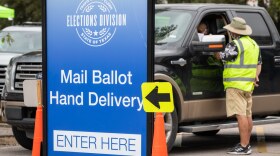Over the weekend, Hays County became the first county in the nation to surpass its 2016 vote totals. Williamson County was soon to follow – breaking its own 2016 record Monday.
What’s driving the turnout? Turns out, there are a number of factors.
A Population Boom
In both counties, population growth is a major factor.
“A lot of Travis County had sprawled out towards the Williamson County area in previous years,” Hays County Elections Administrator Jennifer Anderson said. “And I think as that area is building up now, they're coming more towards Hays and filling in that gap between Travis and Bexar County.”
Jeremi Suri, a historian at the LBJ School of Public Affairs at UT Austin, said it’s common to hear about people who work in Round Rock and live in Austin, or vice versa.
“But, of course, there are tons of people now who work in Hays County, even live in San Marcos in some cases, and commute up to Austin,” he said.
The influx of residents from Travis, but also from out of state, brings a new set of views and voting patterns to these historically conservative counties. And, Suri said, a large number of those who come in from out-of-state are typically registered Democrats.
But it’s not just about party affiliation.
“They come in having already voted somewhere else. And what we know as scholars is that once you vote, you are more likely to vote again,” Suri said. “And so they're coming from states that had higher turnout than Texas in the past. They bring a culture of voting, a set of habits of voting to Texas. So it's not just their party affiliation, it's that they're voters.”
The Williamson County elections office said it prioritizes making sure out-of-towners know how to vote in the county.
“We view our primary mission as lowering that barrier of entry into voting, the information hurdle, making it clear who they're voting for, what races are on the ballot, where they vote,” Elections Administrator Chris Davis said. “Those basic questions, we’re working really hard to make that information easily accessible.”
He said he thinks those efforts have resulted in high vote totals.
Democrats Moving In
As cities in Hays County become more connected to Austin and San Antonio, they start to look more like them, Suri said. It’s no longer the same semi-rural county it once was.
“I think Hays County is ground zero for the changes that are happening in American suburbs,” Suri said. “Now it looks like what suburbs look like in the U.S. Suburbs are diverse. Suburbs have women who work, who don't stay at home. Suburbs have smaller families. And suburbs have people who are highly educated.”
There are still a lot of Republican voters in Hays County, he said, but “there's every reason to believe that as the voting numbers are going up, they're going up higher for those who are more likely to vote Democrat.”
And a major question in Hays County this election season is whether Democrats can build on the wins they made in 2018 or if Republicans can make a comeback.
Democrats also picked up some key seats in Williamson County that year – and they’ll be trying to hold onto them this fall. But Emily Sydnor, an assistant professor of political science at Southwestern University, said a lot of excitement is coming from races down the ballot – like the sheriff’s race.
“There is a confluence of both the changing demographics and the motivations that come from exciting races, from compelling candidates, from being mobilized by parties and groups and communities that makes this more unique than it might have been otherwise,” Sydnor said.
The Pandemic
There’s also the pandemic.
Williamson and Hays have been hit hard by the virus – the same way that more crowded and dense counties in Texas have been. And that affects the way people show up to vote.
Many people are going early to the polls for shorter, spaced-out lines – hoping to beat Election Day crowds.
“Hays County and Williamson County in some ways have been affected even worse than Austin, depending on how you measure it,” Suri said. “[COVID-19 is] the number one issue – even Republicans are looking at,” and that is partially behind the high early voter turnout.
If you found the reporting above valuable, please consider making a donation to support it. Your gift pays for everything you find on KUT.org. Thanks for donating today.








